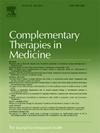针灸对慢性疲劳综合征患者心率变异性的影响:调节自主神经系统的临床随机对照试验
IF 3.3
3区 医学
Q1 INTEGRATIVE & COMPLEMENTARY MEDICINE
引用次数: 0
摘要
背景:本研究探讨不同针灸手法、特定穴位及其组合对慢性疲劳综合征(CFS)患者症状改善的影响及其对心率变异性(HRV)指标的影响。方法:选取健康受试者35例作为健康对照组(a组)和慢性疲劳综合征患者175例,随机分为假针组(B组)、足三里(ST36)穴针刺组(C组)、冠元(CV4)穴针刺组(D组)、双穴针刺组(E组)和艾灸组(F组),每组35例。B组同时在双侧足三里穴和官源穴进行假针刺。C组针刺双侧足三里穴,假针灌穴。D组针刺观源穴,同时假针双侧足三里穴。E组患者双侧足三里穴和官源穴同时针灸,F组患者双侧足三里穴和官源穴同时针灸。每组共治疗10次,每隔一天给药一次。治疗前对所有受试者进行气虚证评分、CFS评分、SF36评分。分别在治疗前、第一次治疗后、第四次治疗后和治疗结束时测量HRV。结果:针刺和艾灸均能有效缓解CFS患者的疲劳症状,且针刺和艾灸联合治疗效果更佳。结论:针刺在调节HRV的近期效应上优于针刺,而艾灸在调节HRV的远期效应上优于针刺。同时针刺足三里和官园穴比单一针刺更有效,这一差异反映在对交感和副交感神经系统的不同调节作用上。足三里的干预机制可能涉及副交感神经系统,而官源可能通过交感神经系统起作用。试验注册:经湖北省中医院医学伦理委员会批准(批准号:HBZY2016-C24-01),并在北美临床试验数据中心(Clinical Trials.gov)注册(2016/10/05)(注册号:NCT02924831)。本文章由计算机程序翻译,如有差异,请以英文原文为准。
Effects of acupuncture and moxibustion on heart rate variability in chronic fatigue syndrome patients: Regulating the autonomic nervous system in a clinical randomized controlled trial
Background
This study investigates the effects of various acupuncture techniques, specific acupuncture points, and their combinations on symptom improvement in chronic fatigue syndrome (CFS) patients as well as their influence on heart rate variability (HRV) indicators.
Methods
We recruited 35 healthy subjects as a healthy control group (Group A) and 175 patients with CFS, who were randomly divided into a fake acupuncture group (Group B), an acupuncture group targeting the Zusanli (ST36) point (Group C), an acupuncture group targeting the Guanyuan (CV4) point (Group D), a dual-acupoint acupuncture group (Group E), and a moxibustion group (Group F), with 35 patients in each group. Group B received fake acupuncture at both the bilateral Zusanli and Guanyuan points simultaneously. Group C received acupuncture at the bilateral Zusanli points along with fake acupuncture at the Guanyuan point. Group D received acupuncture at the Guanyuan point along with fake acupuncture at the bilateral Zusanli points. Group E received acupuncture at both the bilateral Zusanli and Guanyuan points simultaneously, and Group F received moxibustion at both the bilateral Zusanli and Guanyuan points simultaneously. Each group received a total of 10 treatments, administered every other day. Before treatment, the Qi-deficiency Syndrome Score, CFS Score, and SF36 Score were assessed for all subjects. HRV was measured before treatment, after the first treatment, after the fourth treatment, and at the end of treatment.
Results
The results showed that both acupuncture and moxibustion can effectively alleviate fatigue symptoms in patients suffering from CFS, with combined acupuncture and moxibustion demonstrating greater effectiveness.
Conclusion
Acupuncture excelled in regulating the immediate effects of HRV, while moxibustion excelled in regulating long-term effects. Acupuncture targeting both the Zusanli and Guanyuan points proved more effective than acupuncture targeting a single point, with this difference reflected in the distinct regulatory effects on the sympathetic and parasympathetic nervous systems. The intervention mechanism of Zusanli may involve the parasympathetic nervous system, whereas Guanyuan may operate through the sympathetic nervous system.
Trial registration
Approved by the Medical Ethics Committee of Hubei Provincial Hospital of Traditional Chinese Medicine (Approval number: HBZY2016-C24-01), and registered with the North American Clinical Trials Data Center (Clinical Trials.gov) (05/10/2016) (registration number: NCT02924831).
求助全文
通过发布文献求助,成功后即可免费获取论文全文。
去求助
来源期刊

Complementary therapies in medicine
医学-全科医学与补充医学
CiteScore
8.60
自引率
2.80%
发文量
101
审稿时长
112 days
期刊介绍:
Complementary Therapies in Medicine is an international, peer-reviewed journal that has considerable appeal to anyone who seeks objective and critical information on complementary therapies or who wishes to deepen their understanding of these approaches. It will be of particular interest to healthcare practitioners including family practitioners, complementary therapists, nurses, and physiotherapists; to academics including social scientists and CAM researchers; to healthcare managers; and to patients. Complementary Therapies in Medicine aims to publish valid, relevant and rigorous research and serious discussion articles with the main purpose of improving healthcare.
 求助内容:
求助内容: 应助结果提醒方式:
应助结果提醒方式:


